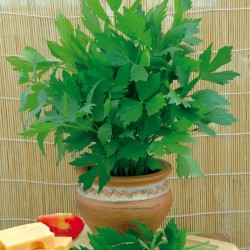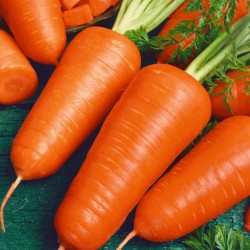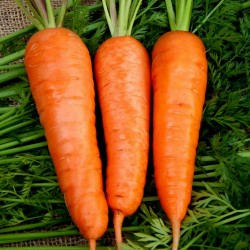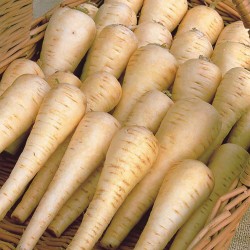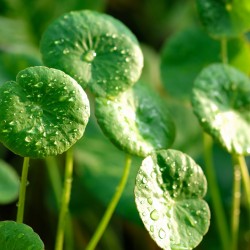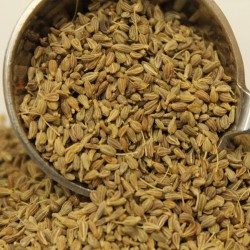
Anijszaad (Pimpinella anisum)
Prijs
€ 2,25
SKU: MHS 7
Seeds Gallery Com,
5/
5
<h2><strong>Anijszaad (Pimpinella anisum)</strong></h2>
<h2><span style="color: #ff0000;"><strong>Prijs voor Pakket van 150+ zaden (0,5g).</strong></span></h2>
<p><strong>Anijs</strong> (<em>Pimpinella anisum</em>) is een plant die behoort tot de schermbloemenfamilie (<em>Umbelliferae</em> of <em>Apiaceae</em>). De "zaden" van anijs wordt gebruikt voor het aromatiseren van gerechten. Steranijs heeft een vergelijkbare smaak als anijs, maar behoort tot een andere familie (<em>Schisandraceae</em>).</p>
<h2><span id="Uiterlijk">Uiterlijk</span></h2>
<p>Anijs wordt ongeveer 50 cm hoog. De onderste bladeren zijn ongedeeld, maar naar boven toe worden de bladeren fijner gevind. Anijs heeft witte bloemschermen, en grauwgroene, peervormige, tweedelige splitvruchten.</p>
<h2><span id="Herkomst">Herkomst</span></h2>
<p>Anijs komt oorspronkelijk voor in het oostelijk deel van het Middellandse Zeegebied en West-Azië. Er is bewijs dat anijs al in het jaar 1500 voor Christus door de Egyptenaren werd gebruikt.</p>
<p>Anijs wordt verbouwd in Zuid-Europa, het Middellandse Zeegebied, Rusland en India, maar de plant komt ook in Nederland verwilderd voor.</p>
<h2><span id="Toepassingen">Toepassingen</span></h2>
<p>Anijs wordt als aromatiserend kruid gebruikt in de keuken en in alcoholische dranken. Traditioneel is het trekken van anijs in melk, dat zeer geurige (maar niet zoete) anijsmelk geeft. Anijsblokjes worden bereid van suiker met anijsolie. Daarnaast wordt aan anijs een medicinale werking toegeschreven hoewel deze niet bewezen is.</p>
<h3><span id="In_de_keuken">In de keuken</span></h3>
<p>Anijs wordt in gerechten toegepast vanwege de bijzondere smaak die het heeft. Een voorbeeld daarvan is anijsbrood. Daarnaast wordt anijs gebruikt voor bijvoorbeeld pepernoten, dranken zoals anijsmelk en verschillende alcoholische dranken.</p>
<p>Anijszaadjes zijn een basisgrondstof voor de muisjes die gebruikt worden voor beschuit met muisjes. Ook worden anijszaadjes gebruikt voor het vervaardigen van de anijskrol. Het woordmerk "Muisjes" is een geregistreerd merk van Koninklijke De Ruijter B.V.</p>
<h3><span id="In_alcoholische_dranken">In alcoholische dranken</span></h3>
<p>Anijs wordt onder meer gebruikt in de Franse pastis (bv. Ricard), de Griekse drank ouzo en de Turkse drank raki. Andere anijshoudende alcoholische dranken zijn absint, sambuca, arak, Bénédictine, Brokmöpke, Elixir d'Anvers, tsikoudia, tsipouro, rakija, Colombiaanse aguardiente, mastika (Bulgarije), hierbas (Spanje) en de Baskische drank patxaran.</p>
<h3><span id="Medicinale_werking">Medicinale werking</span></h3>
<p>Medicinaal wordt anijs gebruikt als spijsverteringsmiddel. In Europa, het Midden-Oosten en in Indiase culturen wordt anijszaad gekauwd na maaltijden om de vertering te vergemakkelijken en om de adem te verfrissen.</p>
<p>Ook wordt anijszaad ingezet als diureticum. Amerikaanse indianen gebruikten het tegen winderigheid (carminativum).</p>
<p>De uit de zaden (Anisi fructus) door destillatie gewonnen anijsolie wordt op grond van zijn slijmoplossende werking als hoestmiddel gebruikt. Het zou echter ook een bactericide werking hebben en tegen spierkramp en winderigheid helpen. De etherische olie van anijs bevat als hoofdbestanddeel anethol, een fyto-oestrogeen met oestrogene werking.<sup id="cite_ref-PMID15368661_1-0">[1]</sup></p>
<p>Zaad en knoppen worden gebruikt als ingrediënt in kraamanijs.</p>
<p><br /><br /></p>
MHS 7 (150 S)





